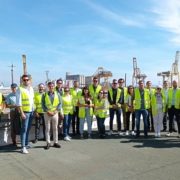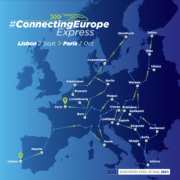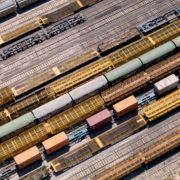The future begins with the letter “R” for the railway

Written by José Andrés Arribas Navarro, Economist and Manager at FAPROVE
We want to talk about the railway. But before that, I wanted to share a brief preamble.
The easiest thing in life is making decisions. The difficult part is ensuring that these decisions are good. To make good decisions, one must not be swayed by the opinions of those in power, pressure groups, short-sighted interests, or dangerous friendships. You need to be convinced and believe in what you’re proposing. The commitment to these decisions should have a long-term perspective, durability over time, and aim to improve the well-being, optimizing the quality of life for all current stakeholders and even future generations.
This is the essence of nation-building and societal improvement. It’s only after many years that we can fully grasp the significance of such a commitment, understand its true scope, and admire the visionary leader who, despite facing numerous challenges, bravely defended the long-term interests of a nation’s citizens against the self-serving and detrimental interests of a privileged few.
I mention this reflection because history has offered us numerous instances of favorable decisions that have enhanced our quality of life. These improvements were made possible through the boldness of visionaries who, in their time, overcame opposition from those motivated by personal and self-serving interests.
The current state of freight rail in the United States can be explained by Lincoln’s determination.
In the latter half of the 19th century, within the United States, each state and private company held the authority to construct railways and determine their own track gauges. Remarkably, by 1871, a staggering 23 distinct gauges existed, ranging from 914 to 1829 mm. The resistance to standardizing rail gauges was rooted in the fact that substantial profits were generated by transferring goods between various trains at state borders, creating employment opportunities through hospitality, trade, maintenance, and more.
Without delving into the debates that unfolded at the end of the Civil War, which centred on the necessity of standardizing track gauges and ending the prevalent disorder, what deserves emphasis is the decision-making process behind finding a long-term solution with a wide-ranging vision, enduring sustainability, and benefits for future generations. In 1865, Abraham Lincoln, after listening to voices from both the South and North and likely recognizing the adoption of ‘Stephenson’s gauge’ by the British Parliament in 1846 (fixing the track gauge at approximately 4 feet 8½ inches or 1,435 mm), resolved that the transcontinental railroad should adopt the 1,435 mm gauge. The project was successfully completed in 1869 at Promontory, Utah. It’s highly probable that a significant portion of the current freight transportation by rail in the United States can be attributed to Lincoln’s unwavering determination.
Turning our attention to a different continent, the 20th century introduced us to another visionary figure whose decision-making was rooted in a concern for future generations. Robert Schuman’s contributions stand as a testament to his unwavering commitment to laying the foundation for the modern European Union. Our gratitude for his relentless efforts can never be overstated.
What’s truly captivating about this idea sown more than seven decades ago is its role in nurturing progress, cultivating democratic values, and fostering solidarity among nations. It has also paved the way for ‘erga omnes’ measures. Presently, the EU comprises 27 member countries out of the 50 on the European continent, with ongoing requests for membership in this exclusive alliance. The departure of the United Kingdom in 2020 serves as a conspicuous example of a misguided decision driven by populism, short-term objectives, and leaders lacking a forward-thinking vision for the well-being of future generations.
The “Digital Automatic Coupling” (DAC) system goes beyond coupling and uncoupling train cars.
The purpose of this extensive preamble is to underscore that it is by no means a coincidence that, just a few weeks ago, on July 10th, an unprecedented sectoral declaration was issued, advocating for the adoption of the ‘Digital Automatic Coupling’ (DAC) system as the standard for implementation across the European railway industry in the context of freight transportation. The DAC’s significance extends beyond the conventional aspects of physically coupling and uncoupling freight train cars without human intervention, which has been the traditional practice. It also encompasses the realm of digitalization, achieved through electrical connections, thus bolstering connectivity and data efficiency. This transformative technology enables the automation of various railway operations, including electronic waybills, train documentation, real-time information, and more. In doing so, it ushers in a genuine revolution aligned with the EU’s Green Deal objectives, with a keen focus on sustainability, decarbonization, and the reduction of greenhouse gas emissions.
In this declaration, all the undersigned parties, including European railway associations, railway companies, manufacturers, wagon owners, carriers, as well as national and European customer associations—comprising over 70 entities across the value chain—demonstrate their unwavering commitment to endorsing automation and digitalization as the future industry standard. This collective commitment is anticipated to pave the way for a safer and more contemporary work environment for employees. Furthermore, in the long term, it is envisioned to be the cornerstone for the revitalization of rail freight transport, fostering its wider adoption and aligning it with ecological and sustainable practices in Europe. The document comprehensively outlines the current scenario and proposes the establishment of a Centralized European Deployment Management Entity, entrusted with overseeing the attainment of three pivotal milestones within this ambitious plan:
- The creation of a governing entity responsible for framing the legal and budgetary foundation,
- The pre-deployment of DAC, scheduled from 2025 to 2028, dedicated to large-scale testing, and
- The formal deployment of the DAC system commencing in 2028.
The verdict from Brussels will shape the destiny of 500,000 freight cars, potentially rendering them interoperable, elevating the market share of rail freight, and realizing the goals of the Green Deal. Most crucially, it will determine the continued growth and prosperity of Robert Schuman’s ‘father of Europe’ vision.
This article originally appeared on the El Mercantil website in Spanish. It is being published here with the author’s permission: https://elmercantil.com/opiniones/futuro-empieza-por-f-de-ferrocarril/









